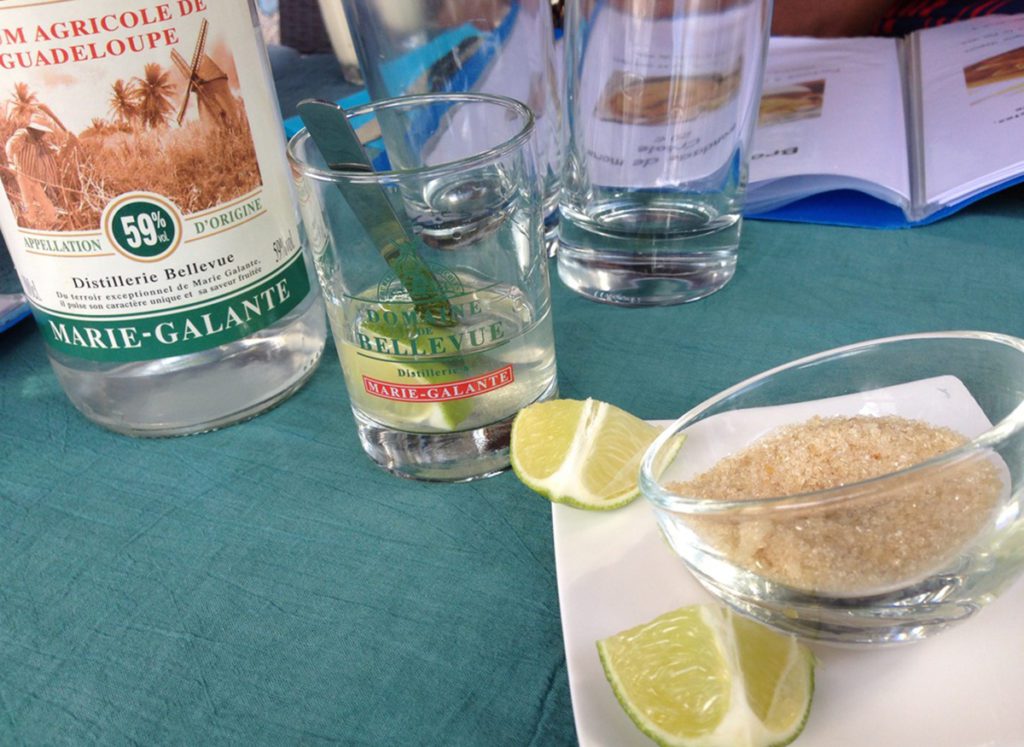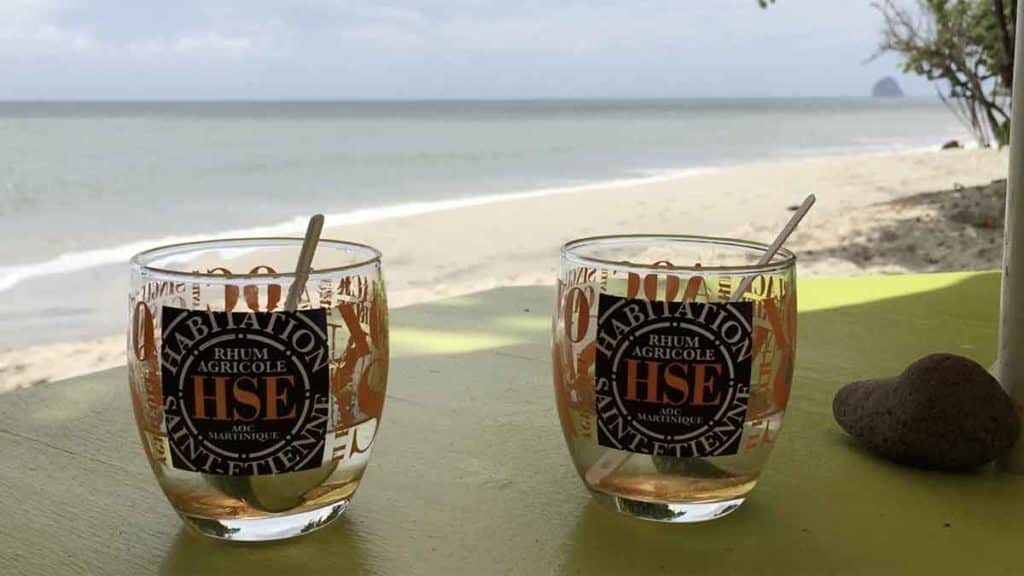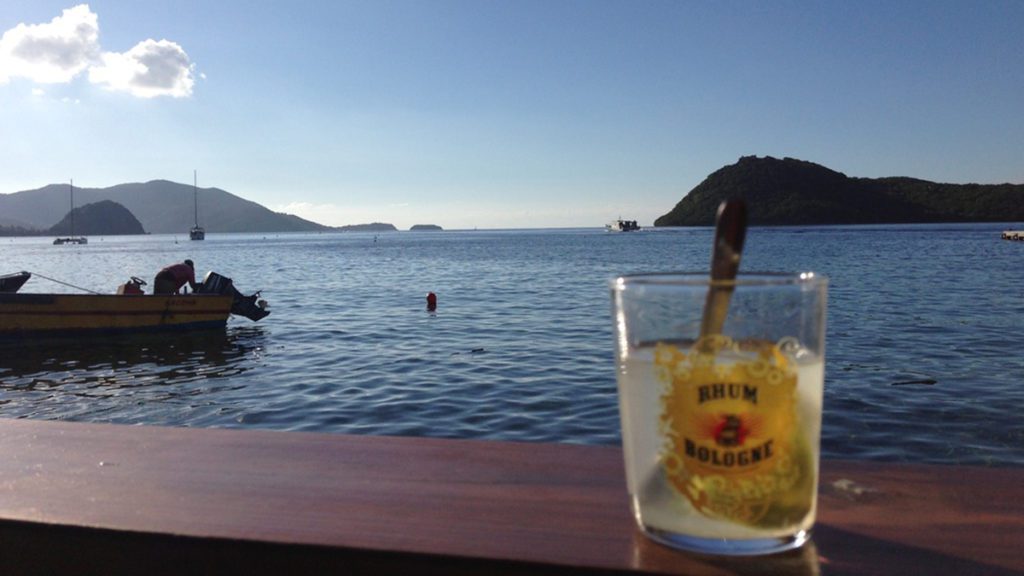It’s the purest expression of sugarcane in spirit form: rhum blanc, or white rhum agricole.
Unaged white rum made from pure pressed sugar cane juice is as close as you can come to the cane: a raw, visceral, complex spirit that has a real terroir.
And it just so happens that this is the primary ingredient in the Caribbean’s ultimate rum cocktail: the ti’ punch.
Ti’ punch, short for petit punch, is the essential drink of the French West Indies, a local, easy-to-prepare drink that’s part of the ritual of daily life in Martinique and Guadeloupe.
It’s ubiquitous, often accompanied by those endlessly delicious codfish fritters called Accras. And it’s a key to immersing yourself in the culture of the French Caribbean.
You cannot begin to understand this enchanting part of the Caribbean without a ti’ punch, a drink whose preparation requires a ceremony on par with tea in Japan.
And it’s deliciously simple to make.
Because while there are myriad dressed-up versions of making the ti’ punch, there’s one truly authentic way to make it — the way people actually drink it at a bar or restaurant in the FWI.
Show up at a beach bar or a cafe (or just about any restaurant at all) in Martinique and Guadeloupe, order a ti’ punch (it’s often cheaper than a bottle of water), and you’ll soon be welcomed with a tray.

There you’ll find three things: a bottle of white rhum, some quarter slices of lime, and a ramequin of brown sugar.
Because white rhum is so affordable, the restaurant will leave it to you how much white rhum you decide to put in the glass, joined with just the quarter lime and, ideally, a teaspoon of sugar.
How much rum you add is up to you, but I like to pour enough that the rum levels right above the top of the lime.
Most importantly, there is no ice in this drink. Ice will rob you of the delicacy, the complexity and the nuance of the cocktail.
I wouldn’t even recommend squeezing the sliver of lime; wayward ti’ punches you might find in places (typically in Saint Martin) far overdo the lime, stuffing the glass with multiple, squeezed lime slices and flooding the drink with abundant, obnoxious citrus.
While sugarcane syrup has become popular in lieu of sugar, for me, syrup can be too sweet, and corrupt the balance of the three ingredients.
Indeed, this is a delicate cocktail, a dance of three players. A small amount of patience is required to give the rum (best between 50 and 60 degrees), the sugar and the lime time to harmonize.
And that’s when the drink hits you, when it all makes sense, when you realize just how wonderful a cocktail this is.

I call it the moment du punch, that instant when the flavors of the rum and the sugar and the lime come together and become something far greater than the sum of their parts, when a ti’ punch really becomes a ti’ punch.
That’s always when a neophyte taking his or her first ti’ punch becomes a ti’ punch partisan and, soon, begins the journey down the rabbit hole of rhum agricole.
Now, you might have had a daiquiri or a caipirinha, two cocktails with largely identical ingredients. Both are fine cocktails.
But without the dimensionality of the rhum agricole, without the right proportions of lime and sugar (or with unnecessary ice), you have a very different, far less interesting experience.
There’s nothing like this drink in the Caribbean, something so perfect, so simple and, most importantly, so local.
If you drink this in Martinique or Guadeloupe, it’s a drink all of whose ingredients are from Martinique or Guadeloupe — the rum, the limes and the sugar are all made there.
If you’re in the United States, the best rhum blanc options are Rhum JM and Rhum Clement, the most widely available agricoles in America, although you can find HSE, Neisson and La Favorite in certain fine spirits shops in the US).
For this year’s National Rum Day, the ti’ punch I prepared was not quite as local as that (limes and brown sugar from, well, not the French Caribbean), but it was splendid, made with one of the most celebrated white rums of all time, the HSE Parcellaire 2016.
That rum is a great example of what makes the rums of the French Caribbean so different.
Parcellaire means the rum was made exclusively from sugar cane grown from just a tiny corner, or parcel, of the sugarcane plantation in Martinique. It’s the terroir of a single corner of a cane field.
That the kind of thoughtful devotion to rum you find in that part of the Caribbean, where this cocktail is part of the soul of the French West Indies.
And when you reach the moment du punch, it all begins to make sense.
The Ti’ Punch
1/4 lime
1 teaspoon sugar
Rhum Blanc agricole; the amount is up to you; typically pour the rum to just above the top of the lime in the glass).
Best enjoyed on a beach in Martinique, Guadeloupe, St Martin or St Barth.
Nickelodeon Resorts’ Preschool Event Is Back in Punta Cana

